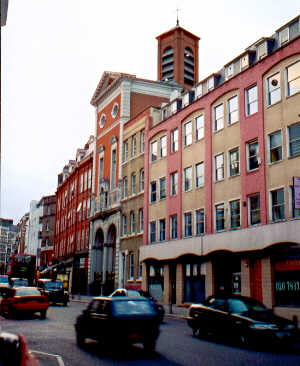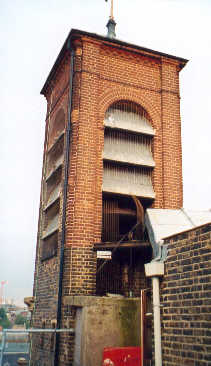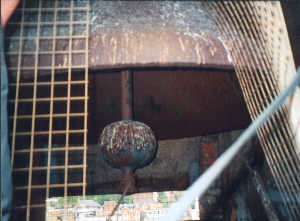The largest steel bell in the UK, cast by Naylor-Vickers of Sheffield in 1862, is in St Peter’s Italian Church, Holborn, London. Dickon Love and I visited it on 27 September 2002. This bell is sometimes know as The Steel Monster of Clerkenwell!
The bell was exhibited at the International Exhibition of 1862. The exhibition catalogue doesn’t specifically mention Naylor-Vickers or this bell, but does have this paragraph in the description of Class 31:
“Two other blocks are occupied by goods of a new class of manufacture, consisting of heavy castings of steel, crank axles for locomotives, driving wheels, axles, tyres, points for crossings, bells, railway-carriage springs, buffers, &c., &c., which it is anticipated will prove of a superior quality to those shown by German manufacturers. The above articles are now being made in large quantities, and have, since the last Exhibition, become one of the most extensive branches of the Sheffield trade.”
After the exhibition, the bell was bought by this church, which was then being built. The weight of the bell is uncertain, a Naylor-Vickers’ catalogue gives its weight as 87 cwt or 4,420kg. The history of the church and some details of the bell are given on the church website.
More information on the history of the bell is given on Dickon Love’s website.

The bell hangs dead in a brick turret above the porch. The bell is almost too big for this turret, and is impossible to photograph in its entirety. The church itself is completely surrounded by buildings (most of which also belong to the church) and is also impossible to photograph from the outside, apart from the porch which was built after the main building. The inside of the church is splendid. The turret in which the bell hangs is visible above the porch in the picture above. The church lies roughly parallel to the road behind the buildings.
At one time this bell was rung regularly for Sunday services, but on my visit I was told that it is now only rung for special festivals.

This picture shows the turret close up. The lip of the bell can just be seen below the bottom louvre. The bell is rung from far below, a chain attached to the clapper runs over a pulley (just visible to the left of the lead roof below the lip of the bell) and then drops vertically down. It is fairly easy to get underneath the bell, and possible to squeeze between it and the louvres to inspect the waist. The crown is too far up to see. To get above the bell would require a ladder to climb in through the louvres above the bell. Beyond the handrail in the bottom left of the picture is a 20 or 30 foot drop to the aisle roof.
The dimensions of the bell are as follows:
- Lip diameter: 228.5cm
- Distance from lip to shoulder: 161cm
- Shoulder diameter: 121.5cm.
The first two measurements are certain, the last was arrived at by taking the internal width of the frame and estimating the space between frame and shoulder on either side.

This picture shows most of the lip of the bell, the clapper (which has an enormous ball and a very thin stem) and the chain by which the clapper is swung. The clapper has inserts on its two striking faces. The one on the opposite side of the clapper has fallen out, that on the visible face still exists and appears to be metal. The bell is hung from a wooden ‘stool’ which is free-standing inside the turret. The bell probably has a flange top, attached to a beam at the top of the stool with four bolts.
The bell has a coat of arms or emblem on its waist, with the word ‘PATENT’ below it. It also has a long inscription around its soundbow which is now too corroded to be read. Chris Pickford gives the inscription as rubbed by Thyssen as ‘NAYLOR VICKERS & Co SHEFFIELD 1862 CAST STEEL / (pattern and monogram NV & Co) / PATENT 2864’.
Heard close to, the sound of this bell is impressive if not tuneful – PC loudspeakers do not do it justice, as many of its partials are low in pitch. The partial frequencies and intervals are as follows:
| Hum | cents | Prime | cents | Tierce | cents | Quint | cents | Nominal | Superquint | cents | Octave Nominal | cents |
|---|---|---|---|---|---|---|---|---|---|---|---|---|
| 127 | -1967 | 200.5 | -1176 | 238 | -879 | 363.5 | -146 | 395.5 | 599.5 | 720 | 941 | 1501 |
These tuning figures are a classic case of Naylor-Vickers’ poor design. The hum is radically sharp, by four semi-tones. The prime is a little sharp, and the quint is quite sharp. The superquint and octave nominal are very sharp, and as a result no clear strike pitch is apparent.
I am grateful to the following people who helped with the investigation of this bell:
- The church authorities, who responded with enthusiasm to my request to inspect and record the bell
- Dickon Love, who accompanied me on the visit
- Chris Pickford, who supplied historical detail about the church and this bell.